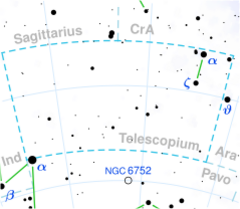Astronomy:Iota Sagittarii
| Observation data Equinox J2000.0]] (ICRS) | |
|---|---|
| Constellation | Sagittarius |
| Right ascension | 19h 55m 15.69691s[1] |
| Declination | −41° 52′ 05.8388″[1] |
| Apparent magnitude (V) | +4.118[2] |
| Characteristics | |
| Spectral type | K0 II-III[3] |
| U−B color index | +0.911[2] |
| B−V color index | +1.084[2] |
| Astrometry | |
| Radial velocity (Rv) | +35.8[3] km/s |
| Proper motion (μ) | RA: +22.61[1] mas/yr Dec.: +51.40[1] mas/yr |
| Parallax (π) | 17.94 ± 0.21[1] mas |
| Distance | 182 ± 2 ly (55.7 ± 0.7 pc) |
| Absolute magnitude (MV) | +0.39[4] |
| Details | |
| Mass | 1.40[3] M☉ |
| Radius | 14[5] R☉ |
| Luminosity | 87[3] L☉ |
| Surface gravity (log g) | 1.89[6] cgs |
| Temperature | 4,594±41[3] K |
| Metallicity [Fe/H] | −0.26[6] dex |
| Age | 4.74[3] Gyr |
| Other designations | |
| Database references | |
| SIMBAD | data |
Iota Sagittarii (Iota Sgr, ι Sagittarii, ι Sgr) is a star in the zodiac constellation of Sagittarius. With an apparent visual magnitude of +4.118, it is bright enough to be viewed with the naked eye.[2] Based upon an annual parallax shift of 17.94 mas as seen from Earth,[1] this star is located 182 light years from the Sun. It is moving away from the Earth with a radial velocity of +35.8 km/s.[3]
This is a probable astrometric binary,[8] based upon proper motion data collected during the Hipparcos mission.[9] The visible component shows the spectrum of an evolved K-type giant or bright giant star with a stellar classification of K0 II-III.[3] The measured angular diameter, after correction for limb darkening, is 2.32±0.02 mas.[10] At an estimated distance of this star, this yields a physical size of about 14 times the radius of the Sun.[5] It has 1.4[3] times the mass of the Sun and is radiating 87[3] times the Sun's luminosity from its photosphere at an effective temperature of about 4,594 K.[3]
References
- ↑ 1.0 1.1 1.2 1.3 1.4 1.5 van Leeuwen, F. (2007), "Validation of the new Hipparcos reduction", Astronomy and Astrophysics 474 (2): 653–664, doi:10.1051/0004-6361:20078357, Bibcode: 2007A&A...474..653V.
- ↑ 2.0 2.1 2.2 2.3 Cousins, A. W. J. (1973), "Revised zero points and UBV photometry of stars in the Harvard E and F regions", Memoirs of the Royal Astronomical Society 77: 223–236, Bibcode: 1973MmRAS..77..223C.
- ↑ 3.00 3.01 3.02 3.03 3.04 3.05 3.06 3.07 3.08 3.09 3.10 Luck, R. Earle (2015), "Abundances in the Local Region. I. G and K Giants", The Astronomical Journal 150 (3): 88, doi:10.1088/0004-6256/150/3/88, Bibcode: 2015AJ....150...88L.
- ↑ Anderson, E.; Francis, Ch. (2012), "XHIP: An extended hipparcos compilation", Astronomy Letters 38 (5): 331, doi:10.1134/S1063773712050015, Bibcode: 2012AstL...38..331A.
- ↑ 5.0 5.1 Lang, Kenneth R. (2006), Astrophysical formulae, Astronomy and astrophysics library, 1 (3rd ed.), Birkhäuser, ISBN 3-540-29692-1, https://books.google.com/books?id=OvTjLcQ4MCQC&pg=PA41. The radius (R*) is given by:
- [math]\displaystyle{ \begin{align} 2\cdot R_* & = \frac{(55.7\cdot 2.32\cdot 10^{-3})\ \text{AU}}{0.0046491\ \text{AU}/R_{\bigodot}} \\ & \approx 27.8\cdot R_{\bigodot} \end{align} }[/math]
- ↑ 6.0 6.1 Soubiran, C.; Le Campion, J.-F.; Cayrel de Strobel, G.; Caillo, A. (June 2010), "The PASTEL catalogue of stellar parameters", Astronomy and Astrophysics 515: A111, doi:10.1051/0004-6361/201014247, Bibcode: 2010A&A...515A.111S.
- ↑ "iot Sgr". SIMBAD. Centre de données astronomiques de Strasbourg. http://simbad.u-strasbg.fr/simbad/sim-basic?Ident=iot+Sgr.
- ↑ Eggleton, P. P.; Tokovinin, A. A. (September 2008), "A catalogue of multiplicity among bright stellar systems", Monthly Notices of the Royal Astronomical Society 389 (2): 869–879, doi:10.1111/j.1365-2966.2008.13596.x, Bibcode: 2008MNRAS.389..869E.
- ↑ Frankowski, A. et al. (March 2007), "Proper-motion binaries in the Hipparcos catalogue. Comparison with radial velocity data", Astronomy and Astrophysics 464 (1): 377–392, doi:10.1051/0004-6361:20065526, Bibcode: 2007A&A...464..377F.
- ↑ Richichi, A. et al. (February 2005), "CHARM2: An updated Catalog of High Angular Resolution Measurements", Astronomy and Astrophysics 431 (2): 773–777, doi:10.1051/0004-6361:20042039, Bibcode: 2005A&A...431..773R.
 |


